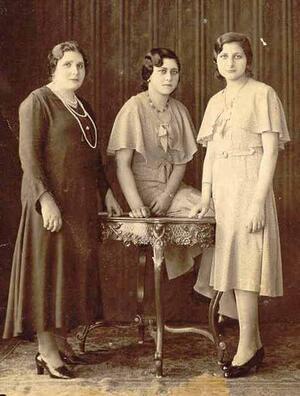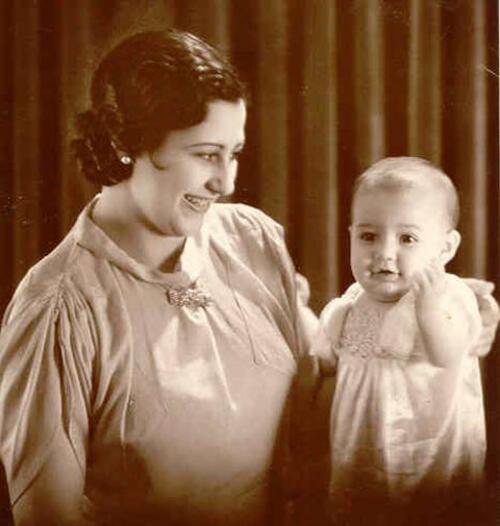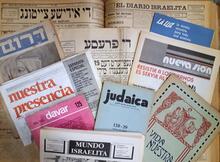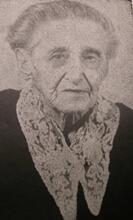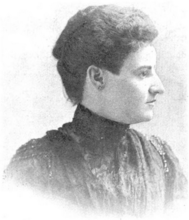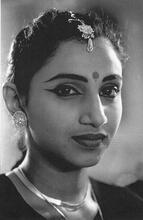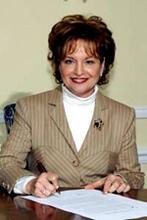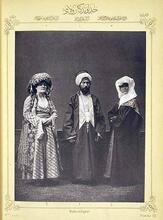Argentina: Sephardic Women
Sephardic women immigrants were instrumental in aiding the process of settling in Argentina. In most cases, they came with their families and made homes in specific neighborhoods and cities depending on their city/region of origin. They tended to marry within their communities until the 1960s, when marriages between Sephardim and Ashkenazim became more common. Sephardic women played an important role in philanthropy, helping communities build synagogues and supporting the poor. Sephardic women did not participate in Women’s International Zionist Organization (WIZO) at first, as most Jewish women there spoke primarily Yiddish. Sephardic women later founded a Sephardic branch within WIZO and helped bring Zionism to the Sephardim. They also raised money to aid the Sephardic community in Jerusalem after the creation of the state of Israel.
Women and Sephardic Immigration
The Sephardic communities that settled in Argentina in the late nineteenth and early twentieth centuries came from various areas in the Sephardi world. The largest community was Arab-speaking, mostly originating in the cities of Aleppo and Damascus. The next in size was the Ladino-speaking community from Turkey and other areas in the former Ottoman Empire. The Moroccan community, primarily from the cities of Tetouan, Larache, and Tangier, was third in size, followed by smaller groups from Jerusalem, Italy, and Yugoslavia.
Some of the first Sephardi women arrived as teachers for the schools the Alliance Israélite Universelle had set up in the agricultural colonies. Graduates of the Alliance schools appeared as early as the 1890s working alongside their husbands in several schools of the colonies of Santa Fé and Entre Ríos. For example, Mme Cecilia Souessia (1884–1966) was one of the teachers working under her husband in the schools in Rivera, Colonie Baron Hirsch. Judith Sabah also worked under her husband Jose Sabah in one of the schools of Colonia Moisesville.
Most of the early Sephardi women immigrants, however, escape the watchful eye of the researcher, since they usually arrived as members of immigrant families and followed a largely anonymous search for a decent and more promising livelihood. The early institutions founded in the new land by the Sephardi immigrants did not include any female founding members, but this is no surprise. It can be assumed, however, that if new religious and community institutions were being created, the population did include a significant number of women.
In their new homes in the interior of Argentina, and in Buenos Aires, women worked alongside their fathers or husbands in the general stores that many Sephardi immigrants opened. While men’s jobs often involved traveling long distances to peddle various wares (another common occupation), women stayed at home doing the household chores and raising the children. Marriage in the first generation of immigrants was endogamous, as social contact with other Jewish groups (even among Descendants of the Jews who lived in Spain and Portugal before the explusion of 1492; primarily Jews of N. Africa, Italy, the Middle East and the Balkans.Sephardim) was rare. Families settled close to other families they knew from their country of origin, and it was these old-country ties that provided the younger generation with suitable spouses. Courtship was usually short and married life began soon after the groom could support the new family. Women, in particular, were watched closely by their families when they came of age, and marriage outside the community and outside the faith was almost unheard of. The Argentine-born generation of the Sephardic immigrant families had more social contact with other Jewish groups, and marriage between Sephardim and Jews of European origin and their descendants, including most of North and South American Jewry.Ashkenazim became more common, although not always welcome.
Philanthropy
Once the various Sephardic communities became established, Sephardi women began to be involved in community organizations, mostly in philanthropic work. Each Sephardic community had its own women’s group in charge of charity; these sometimes acted as part of the religious congregations founded by the men and sometimes independently. References to women’s organizations in Sephardic Buenos Aires appear early on. The Sociedad de Damas de Sión (Society of Women of Zion), for example, appears in the Moroccan community minute books in 1899. In 1908, the Jewish women from Turkey founded El Socorro (The Aid), and in 1918 there were also references to a philanthropic organization called Damas Israelitas Sefaradim de Buenos Aires (Sephardi Jewish Women of Buenos Aires, later called the Asociación Argentina Israel de Damas Hebreas de Beneficencia de Buenos Aires, or Argentine Beneficent Association of Jewish Women of Buenos Aires).
However, philanthropy at this early stage was mostly in the hands of men, who ensured the well-being of all the members of the community by giving money to those men who could not support their families. Women, on the other hand, were rarely the recipients of institutionalized help, receiving support only when their fathers or husbands died and no immediate family could provide the assistance they needed. Male societies then replaced the deceased males as providers.
Women’s societies seem to have acted in the shadow of these male organizations, but little information has survived on the activities of the early women’s charity groups. They surfaced when their work helped community organizations, for their donations and work were usually recorded in these minute books. As mentioned above, in Buenos Aires, the community from the former Ottoman Empire had a women’s group called El Socorro; later, the Sociedad de Damas de Beneficencia La Unión (Women’s Beneficent Society “The Union”) was created by a group of women from Rhodes. In the Syrian community, the women’s society from Damascus, founded in 1927 thanks to the work of Victoria M. de Mohadeb (1901–1977), appears numerous times in the minute books of Bene Emet (the burial society of the community from Damascus). The Moroccan community had several philanthropic organizations, such as the Costurero Marroquí (Moroccan Sewing Club) and the Cooperadora Pro-Templo (Temple Fund), although these were founded much later, in the 1950s. In Flores, a district in Buenos Aires, there were two women’s groups: the Sociedad de Damas Israelitas de Flores (Jewish Women’s Society of Flores) and the Committee of the Club Juventud Israelita (Jewish Youth Club). In the rest of the country, the Sephardic women had also organized for charity. In the city of Córdoba, for example, the Comisión de Damas de la Sociedad Israelita Sefaradí de Socorros Mutuos (Women’s Commission of the Sephardi Mutual Aid Society) was formed in October 1929 and re-organized in 1947. In Santa Fé, la Sociedad Israelita de Damas Sefaradí de Socorros Mutuos (Sephardi Women’s Mutual Aid Society) was founded in 1944. Rosario, Mendoza, and Corrientes also had women’s commissions in charge of philanthropy.
Women’s organizations were instrumental in raising funds to help their communities build synagogues and social halls. In Resistencia, for example, the Sociedad de Damas (Women’s Society) of the Hessed Vehemet [sic] congregation (Mercy and Truth) contributed $45 to the treasury of the organization on September 3, 1929, as funds were being collected for the construction of their social hall. In some cases, the community organizations called on women to lend a hand for specific events. The community from Turkey, for example, created a women’s commission to raise funds to buy a plot of land in Camargo Street, where the community’s synagogue was eventually built. The women were sent to the tenement homes and, thanks to their insistence, they were able to raise the money needed. Jozer Dalim [sic] (Aid for the Poor), one of the Moroccan philanthropic organizations, created a “young ladies’ commission to sell those movie tickets which have been returned unsold.”
With the passage of time, charity became an almost exclusive function of women. Women, it was believed, were morally superior to men and therefore were entrusted with the care of the most sacred, which was the family. To protect, care for, feed, dress, and educate others was accepted as a natural extension of female work in the home. The Congregación Israelita Latina de Buenos Aires (Latin Jewish Congregation of Buenos Aires) in 1927 expressed this idea when they noted both “the need to give a greater impulse to philanthropy” and that the female element was the “most suited to perform it.” In fact, the main Moroccan philanthropic organization Hessed Vehemet became a women’s organization that is still active today.
Education
Education for women was not always a priority among Sephardic families. Parents were required by law to send their children to the first few years of public school, but after that, continuing with schooling depended on the situation at home. If there were many siblings to look after, older daughters tended to stay at home and help their mothers, especially in the interior towns and cities, where life was harsh and labor intensive. With the passing of time, attitudes changed and teaching became the career of choice for young Argentine Sephardic women. This was a profession that allowed women to combine “nurturing elements” with their desire to learn and work outside the home. In place of formal education, women were encouraged to learn a trade and were usually sent to take sewing classes—training that, besides helping women cut costs in the family budget, sometimes came in handy if they needed to work to make ends meet.
Early on, religious education was not an option for Sephardic women, and the schools set up by the Sephardic congregations only accepted young boys. Since this instruction was geared toward the preparation for Lit. "son of the commandment." A boy who has reached legal-religious maturity and is now obligated to fulfill the commandmentsbar mitzvah, it was deemed irrelevant for young women. As the participation of women in religious rituals became more accepted, young girls were allowed to attend religious schools. In the 1950s, girls began attending Talmudei Torah she-bi-khetav: Lit. "the written Torah." The Bible; the Pentateuch; Tanakh (the Pentateuch, Prophets and Hagiographia)Torah which had in the past been open only to young males. Also in 1950, Rabbi Aaron Angel of the Ladino-speaking congregation ACIS began preparing girls for Lit. "son of the commandment." A boy who has reached legal-religious maturity and is now obligated to fulfill the commandmentsbat mitzvah; Or Torah and Agudat Dodim, both Syrian-Jewish Congregations, began offering this ceremony in the 1980s.
Zionism
Another area in which we find organized female activity within the various Sephardic communities is Zionism. The Sephardic branch of WIZO (Women’s International Zionist Organization) was founded in 1946. Although some Sephardi women had participated in the early years of WIZO, Bruria Elnecavé (b. 1915) being the most famous, language and cultural differences made it hard to sustain collaborative enterprises. Yet just as Jewish women’s participation in the Zionist movement had not started with the founding of WIZO, so Sephardi women’s participation in the Zionist project did not start with the creation of WIZO. The Sephardi Zionist movement had also used “the female element” for fund-raising activities. The first Centro Sionista Sefaradí (Sephardi Zionist Center), for example, selected a group of women to sell tickets for a festival they had organized. The second Centro Sionista Sefaradí asked a group of women to be in charge of the collection boxes [alcancías], because “given previous experiences, it will be successful.” However, these women never created their own organization, and although as early as 1925 the idea of forming a Comisión de Damas (Women’s Comission) within the Centro Sionista Sefaradí was frequently discussed during the meetings, it was only in 1945 that it actually took place.
The relationship between WIZO and the Sephardi sector went well at first. The activities of these women, led by Mrs. Bonomo in Capital Federal and other members of the Sephardi community in cities such Córdoba, Paraná, Tucumán, Resistencia, and Corrientes, mirrored those organized by other WIZO centers. They raised money for tree-planting by the Keren Kayemet le-Israel (Jewish National Fund) and collected donations during Circumcisionberit milah ceremonies, Lit. "son of the commandment." A boy who has reached legal-religious maturity and is now obligated to fulfill the commandmentsbar mitzvah celebrations, festivals, “tea-bridges” (afternoon events in which the women played bridge), and so on. In the provincial towns where Sephardi WIZO opened their own chapters, it seems that women’s participation began only once the center was created, since the much older Ashkenazi centers had not succeeded in attracting the Sephardi element. In even smaller towns, where Jewish life was more united due to practical considerations, single WIZO chapters were formed.
After the Segunda Convención Regional Sefaradí (Second Regional Sephardi Convention) in 1948, conflicts among the Sephardi women threatened to do away with a Sephardic WIZO. This regional convention created a Consejo Central Sefaradí (Sephardi Central Council), which organized its own Consejo Central de Damas Sefaradíes (Sephardi Women’s Central Council). The Sephardi women already grouped in Sephardi WIZO centers were asked to join the newly formed council, but the evidence is ambiguous as to whether they actually did so. Sephardic WIZO, for example, continued to work within the Argentine WIZO until the 1980s, when it ceased to be a separate group and became integrated into the larger group.
Evidence indicates that the newly created Central Council of Sephardi Women in fact worked alongside WIZO, sending representatives to the WIZO annual meetings and participating in WIZO’s main fundraising drives. For one such campaign, the Consejo Central de Damas Sefaradíes donated enough money to build a pavilion at the Afulah farm in Israel, which was supported by WIZO Argentina. In recognition of their work, WIZO placed a plaque on the door of the pavilion bearing the name Consejo Central de Damas Sefaradíes. Their commitment to helping Argentine WIZO in the upkeep of the farm in Afulah did not end with the building of the pavilion, since the ladies pledged to support the children of the kindergarten for six months.
Just as Afulah had become an important symbol for WIZO Argentina (see Women and Zionist Activities in Argentina), the children’s pavilion became a source of pride for the Council. Once the building was constructed, the council requested pictures that were used in their fund drives. Whenever a member of the council traveled to Israel, she visited the pavilion donated by her organization.
Evidence is scanty regarding other activities in which the Central Council of Sephardi Women engaged. In 1948, the group successfully staged a play by Ben Hecht called Nace una Bandera (A Flag is Born), and in order to sell tickets for this performance they requested the help of the newly created Consejo Central Juvenil Sefaradí (Central Council of Sephardi Youth). The Women’s Council also created a youth sub-committee, Juventud Oriente Israel (Mizrahi Youth: Israel), which in 1948 began “a series of cultural gatherings.” The play and the cultural evenings suggest that the council was, in fact, more than just a fundraising organization and was interested in spreading the Zionist idea to the young people, with whom it worked in close collaboration.
Yet another group of Sephardi women created the Comité Femenino Sefaradí Amigos de la Histadrut (Sephardi Women’s Friends of the Histradrut) in October 1945. Founded in 1920 in Palestine as a Jewish workers’ trade union, the Histadrut had always claimed that women held a prominent place in its ranks. In Argentina, the Comité Femenino Sefaradí (later called Amigas de Naamat) was founded and led for many years by Judith Isajaroff (1911–2001), a Sephardi woman from Samarkand who participated in Argentine Jewish politics as a member of Mapai (Israel Labor Party), the party that controlled both the Histadrut (General Federation of Workers in Israel) in Israel and local Argentine Jewish politics. In 1950, she was one of the four women candidates in the election of delegates to the twenty-third World Zionist Congress, a fact that was used by the party to demonstrate its commitment to placing women in the vanguard of the new nation’s creation. The organizations centered on raising money for various causes, from helping defray the costs of buying a boat that would be used to “join Tel-Aviv and Buenos Aires,” to supporting kindergartens and various vocational schools. The members also sponsored theater productions, art classes, Hebrew classes, Bible courses and dances. In 1947 the organization had five hundred members, all “conscious bearers of the Zionist ideal,” who had created a sewing workshop and youth groups, as well as doing much work in support of the Jewish National Fund. This group is still active.
Yet another group of Sephardi women raised money for the Sephardi community in Jerusalem, specifically for the Asociación Benot Yerushalaim (Association of Daughters of Jerusalem), which “carried out philanthropic and social work of wide-ranging proportions among the needy Sephardi community.” The women in Palestine “periodically received the material support of the Comisión de Damas del Centro Sionista Sefaradí de Buenos Aires,” which sent them 16,113 pesos, an amount raised during tea parties and other fundraising activities. The Argentine group, known both as the Comisión de Damas del Centro Sionista Sefaradí and the Asociación Benot Yerushalaim, was one of the organizations that participated in the Segunda Regional Sefaradí Argentina.
As was the case with all Sephardi Zionist organizations, participation in the movement created an allegiance that was able to override distinctions of origin. Sephardi women participated in the Argentine women’s organizations as Descendants of the Jews who lived in Spain and Portugal before the explusion of 1492; primarily Jews of N. Africa, Italy, the Middle East and the Balkans.Sephardim, regardless of where their families (or they themselves) had come from. And as Argentine Sephardim, they positioned themselves within the global Zionist project by helping those Sephardim in Palestine who needed such help.
Brodsky, Adriana. "Electing 'Miss Sefaradí,' and 'Queen Esther': Sephardim, Zionism, and Ethnic and National Identities in Argentina, 1933-1971." In The New Jewish Argentina: Facets of Jewish Experiences in the Southern Cone, edited by Raanan Rein and Adriana Brodsky, 179-211. Leiden: Brill, 2012.
Brodsky, Adriana. Sephardi, Jewish, Argentine: Community and National Identity, 1880-1960. Bloomington, IN: Indiana University Press, 2016.
Brodsky, Adriana. "The Battle against Guefilte Fish: Asserting Sephardi Culinary Repertoires among Argentine Jews in the Second Half of the Twentieth Century." In Global Jewish Foodways: A History, edited by Hasia R. Diner and Simone Cinotto. Lincoln: University of Nebraska Press, 2017.

